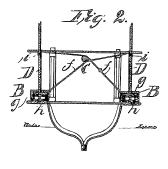According to
a press release from the World Intellectual Property Organization, 45 instruments of accession or ratification of treaties administered by WIPO were deposited in 2005. On April 28, 2005 the Patent Law Treaty (PLT) also entered into force.
WIPO ConventionThe Convention Establishing the World Intellectual Property Organization was signed at Stockholm on July 14, 1967, and entered into force in 1970. WIPO is responsible for the promotion of the protection of intellectual property throughout the world through cooperation among states, and for the administration of various multilateral treaties dealing with the legal and administrative aspects of intellectual property.
In 2005, Afghanistan and Comoros (2) adhered to the WIPO Convention.
The total number of contracting parties on December 31, 2005, was 183.
Paris ConventionThe Paris Convention for the Protection of Industrial Property was concluded in 1883 and is one of the pillars of the international intellectual property system. It applies to industrial property in the widest sense, including inventions, marks, industrial designs, utility models (a kind of "small patent" provided for by the laws of some countries), trade names (designations under which an industrial or commercial activity is carried on), geographical indications (indications of source and appellations of origin) and the repression of unfair competition.
In 2005, Comoros (1) adhered to the Paris Convention.
The total number of contracting parties on December 31, 2005, was 169.
Patent Cooperation Treaty (PCT)The Patent Cooperation Treaty (PCT), concluded in 1970, makes it possible to seek patent protection for an invention simultaneously in each of a large number of countries by filing an "international" patent application. Such an application may be filed by anyone who is a national or resident of a contracting state. The treaty regulates the formal requirements with which any international application must comply.
In 2005, Comoros, Libyan Arab Jamahiriya, Nigeria and Saint Kitts and Nevis (4) adhered to the PCT.
The total number of contracting parties on December 31, 2005, was 128.
Madrid Agreement and Madrid Protocol
The Madrid system for the International Registration of Marks (the Madrid system) is governed by two treaties: the Madrid Agreement Concerning the International Registration of Marks (Madrid Agreement) and the Protocol Relating to the Madrid Agreement Concerning the International Registration of Marks (Madrid Protocol).
The Madrid Agreement was concluded in 1891, and the Madrid Protocol was concluded in 1989 in order to introduce certain new features into the Madrid system. These features address the difficulties that prevent certain countries from adhering to the Madrid Agreement by rendering the system more flexible and more compatible with the domestic legislation of these countries.
In 2005, Bahrain (1) adhered to the Madrid Protocol.
The total number of contracting parties to the Madrid Protocol on December 31, 2005, was 67.
Nice AgreementThe Nice Agreement Concerning the International Classification of Goods and Services for the Purposes of the Registration of Marks was concluded in 1957 and establishes a classification of goods and services for the purposes of registering trademarks and service marks. The Classification consists of a list of classes (based on types of products and services) of which there are 34 for goods and 11 for services and an alphabetical list of the goods and services.
In 2005, Bahrain, Egypt, Jamaica and Saint Kitts and Nevis (4) adhered to the Nice Agreement.
The total number of contracting parties on December 31, 2005, was 78.
Vienna Agreement
The Vienna Agreement Establishing an International Classification of the Figurative Elements of Marks was concluded in 1973. The Vienna Agreement establishes a classification system for marks consisting of or containing figurative elements. The classification comprises 29 categories, 144 divisions and some 1,887 sections in which the figurative elements of marks are classified.
In 2005, Jamaica (1) adhered to the Vienna Agreement.
The total number of contracting parties on December 31, 2005, was 21.
Locarno AgreementThe Locarno Agreement Establishing an International Classification for Industrial Designs was concluded in 1968. It establishes a classification for industrial designs which consists of 32 classes and 223 subclasses based on different types of products. It also comprises an alphabetical list of goods with an indication of the classes and subclasses into which these goods fall. The list contains some 6,600 indications of different kinds of goods.
In 2005, Latvia (1) adhered to the Locarno Agreement.
The total number of contracting parties on December 31, 2005, was 45.
Budapest Treaty
The Budapest Treaty on the International Recognition of the Deposit of Microorganisms for the Purposes of Patent Procedure was concluded in 1977. The main feature of the Budapest Treaty is that a contracting state which allows or requires the deposit of microorganisms for the purposes of patent procedure must recognize, for such purposes, the deposit of a microorganism with any "international depositary authority," irrespective of whether such authority is on or outside the territory of the said state. This eliminates the need to deposit in each country in which protection is sought.
In 2005, Georgia (1) adhered to the Budapest Treaty.
The total number of contracting parties on December 31, 2005, was 61.
Nairobi Treaty
The Nairobi treaty on the Protection of the Olympic symbol was concluded in 1981. All contracting states are obliged to protect the Olympic symbol (the five interlaces rings) against use for commercial purposes (in advertisements, on goods, as a mark, etc.) without the authorization of the International Olympic committee.
In 2005, Romania (1) adhered to the Nairobi Treaty.
The total number of contracting parties on December 31, 2005, was 44.
Lisbon Agreement
The Lisbon Agreement for the Protection of Appellations of Origin and their International Registration was concluded in 1958. It aims to provide for the protection of appellations of origin, that is, the "geographical name of a country, region, or locality, which serves to designate a product originating therein, the quality and characteristics of which are due exclusively or essentially to the geographic environment, including natural and human factors".
In 2005, Iran (Islamic Republic of) and Peru (2) adhered to the Lisbon Agreement.
The total number of contracting parties on December 31, 2005, was 24.
The Hague AgreementThe system of international registration of industrial designs is governed by the Hague Agreement Concerning the International Registration of Industrial Designs which dates from 1925 and has been revised at various times, in particular in London (1934 Act) and the Hague (1960 Act). A new Act of the Hague Agreement was adopted in Geneva on July 2, 1999.
The Geneva Act of the Hague Agreement Concerning the International Registration of Industrial Designs was concluded in 1999 and seeks to make the system more responsive to the needs of users and to facilitate adherence by countries whose industrial designs systems do not permit them to accede to the 1960 Hague Act.
In 2005, The former Yugoslav Republic of Macedonia, Latvia and Singapore (3) adhered to the Geneva Act of the Hague Agreement.
The total number of contracting parties on December 31, 2005, was 19.
Patent Law Treaty (PLT) Concluded in 2000 and entered into force in April 28, 2005, the Patent Law Treaty (PLT) aims to harmonize and simplify formality procedures in order to result in cost reduction, increase of patent offices' efficiency, reduction of risk of errors and consequent less frequent loss of rights. With a significant exception for the filing date requirements, the PLT provides maximum sets of requirements which the office of a contracting party may apply: the office may not lay down any other formal requirements in respect of matters dealt with by this Treaty.
In 2005 Bahrain, Finland, Romania and the United Kingdom (4) adhered to the PLT.
The total number of contracting parties on December 31, 2005, was 13.
Berne Convention
The Berne Convention for the Protection of Literary and Artistic Works was concluded in 1886. It sets out and defines minimum standards of protection of the economic and moral rights of authors of literary and artistic works.
In 2005, Comoros, Nepal and Uzbekistan (3) adhered to the Berne Convention.
The total number of contracting parties on December 31, 2005, was 160.
Rome ConventionThe Rome Convention for the Protection of Performers, Producers of Phonograms and Broadcasting Organizations, concluded in 1961, secures protection of performers on their performances, phonograms of producers of phonograms and broadcasts of broadcasting organizations.
In 2005, Azerbaijan and Bahrain (2) adhered to the Rome Convention.
The total number of contracting parties on December 31, 2005, was 82.
WIPO Copyright Treaty (WCT)
The WIPO Copyright Treaty (WCT) was concluded in 1996. It extends copyright protection to two additional subject matters: (i) computer programs and (ii) compilations of data or other material ("databases") in any form, which by reason of the selection or arrangement of their contents constitute intellectual creations. It also provides for new rights which correspond to the new forms of exploitation of protected works in the digital environment.
In 2005, Albania, Bahrain, Dominican Republic, Oman, Qatar and Singapore (6) adhered to the WCT.
The total number of contracting parties on December 31, 2005, was 56.
WIPO Performances and Phonograms Treaty (WPPT)The WIPO Performances and Phonograms Treaty (WPPT) was concluded in 1996. The treaty deals with intellectual property rights of two kinds of beneficiaries: (i) performers (actors, singers, musicians, etc.), and (ii) producers of phonograms (the persons or legal entities who or which take the initiative and have the responsibility for the fixation of the sounds). They are dealt with in the same instrument because most of the rights granted by the treaty to performers are rights connected with their fixed, purely aural performances (which are the subject matter of phonograms).
In 2005, Bahrain, Cyprus, Dominican Republic, Oman, Qatar, Singapore and United Arab Emirates (7) adhered to the WPPT.
The total number of contracting parties on December 31, 2005, was 55.
UPOV Convention (plant varieties)The International Convention for the Protection of New Varieties of Plants (the UPOV Convention) was concluded in 1961. The objective of the Convention is the protection of new varieties of plants by an intellectual property right.
In 2005, Albania and the European Community (2) adhered to the 1991 Act of the UPOV Convention.
The total number of contracting parties on December 31, 2005, was 60.







 Presumably, a patent Examiner would then review this information before deciding whether to make it part of the record in the official file history. Of course, the devil is always in the details, and Erlich still sees the following "
Presumably, a patent Examiner would then review this information before deciding whether to make it part of the record in the official file history. Of course, the devil is always in the details, and Erlich still sees the following "









